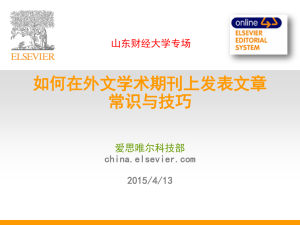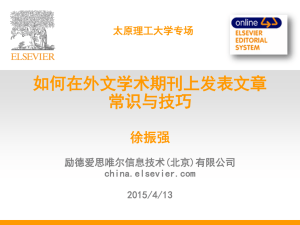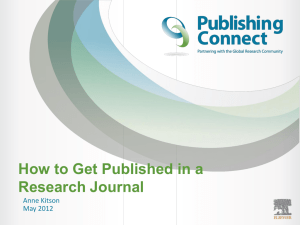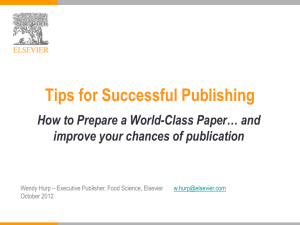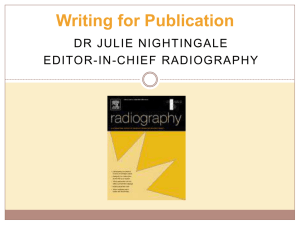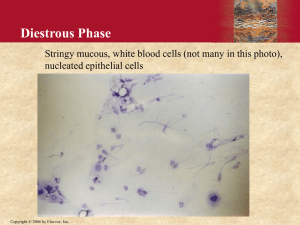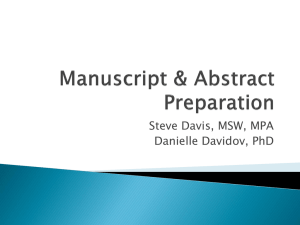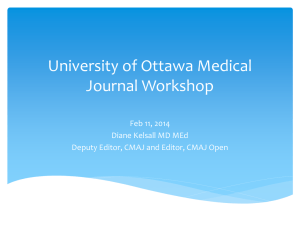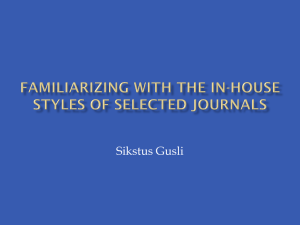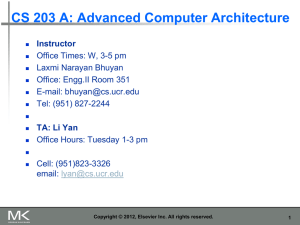The review process - Elsevier網站Taiwan.elsevier.com
advertisement
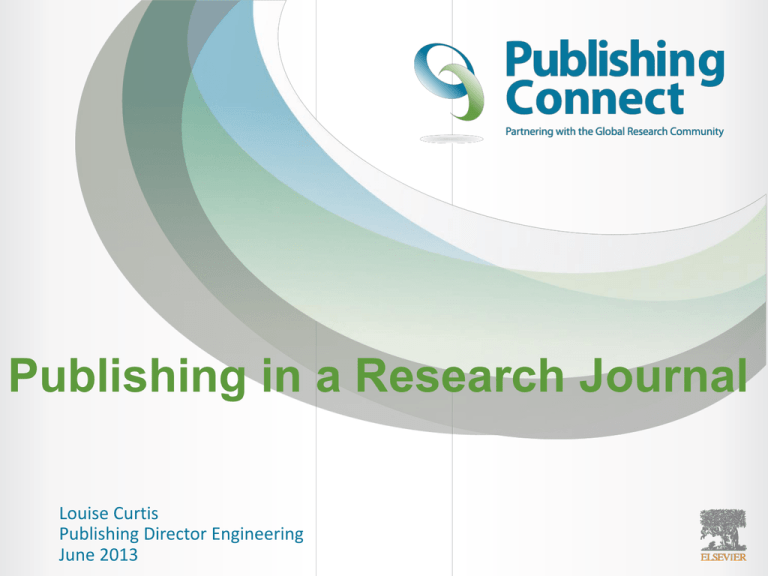
Publishing in a Research Journal Louise Curtis Publishing Director Engineering June 2013 Introduction • Publishing Director, Engineering journals • Responsible for a team of 8 publishers • Working on a portfolio of 120 Engineering journals with over 700 external editors Civil Engineering Chemical Engineering Citation share 70% Citation share 67% 2010 market share in published articles /citations Mechanics Citation share 48% Chang Gung University Each year •3 million articles submitted •1.5 million articles published •30 million readers •2 billion digital article downloads •30 million article citations Source: Knowledge Networks and Nations: Royal Society 2011 http://royalsociety.org/uploadedFiles/Royal_Society_Content/In fluencing_Policy/Reports/2011-03-28-Knowledge-networksnations.pdf Outline • • • • • Initial Considerations • Are you ready to publish ? • The right paper type and the right journal Preparing a good manuscript The review process Author rights and responsibilities Online developments Initial Considerations INITIAL CONSIDERATIONS Are you ready to publish? Consider publishing if you have information that advances understanding in a specific research field This could be in the form of: • Presenting new, original results or methods • Rationalizing, refining, or reinterpreting published results • Reviewing or summarizing a particular subject or field If you are ready to publish, a strong manuscript is what is needed next INITIAL CONSIDERATIONS What is a strong manuscript? • Has a clear, useful, and exciting message • Presented and constructed in a logical manner • Reviewers and editors can grasp the significance easily Editors and reviewers are all busy people – make things easy to save their time INITIAL CONSIDERATIONS Paper types – Full articles / Original articles: substantial and significant completed pieces of research. – Letters / Rapid Communications/ Short communications: quick and early communication of significant and original advances. Much shorter than full articles (check limitations). – Review papers / perspectives: summarize recent developments on a specific topic. Highlight important previously reported points. Not the place to introduce new information. Often invited. – Conference Papers: Excellent for disseminating early or inprogress research findings. Typically 5-10 pages. INITIAL CONSIDERATIONS Choosing the right journal – – – – – Look at your references. Review recent publications in each candidate journal.. Journal specific data e.g. impact factor, time to publish etc Decide on one journal. DO NOT submit to multiple journals Consider journals’ Guides/Instructions for Authors Article history: Received :2 December2011 Received in revised form: 14 May 2012 Accepted: 14 June 2012 Available online :1 July 2012 INITIAL CONSIDERATIONS Elsevier journal metrics INITIAL CONSIDERATIONS Elsevier journal finder journalfinder.elsevier.com INITIAL CONSIDERATIONS Using Scopus to learn about a journal INITIAL CONSIDERATIONS Using Scopus to compare journals Preparing a good manuscript PREPARATION Constructing your article • Title • Abstract • Keywords The Make them easy for progression of the thematic indexing and searching! (informative, attractive, scope of a paper: effective) general specific general • Main text (IMRAD) Journal space is not However, we often write in the – Introduction unlimited. – Methods following order: Make your article as – Results as possible. – Figuresconcise and tables – And – Discussions– Methods, Results and Discussion • Conclusions – Conclusions and Introduction • Acknowledgements – Abstract and title • References • Supplementary Data PREPARATION Title – some examples Original Title Revised Remarks Preliminary observations on the effect of Zn element on anticorrosion of zinc plating layer Effect of Zn on anticorrosion of zinc plating layer Long title distracts readers. Remove all redundancies such as “observations on”, “the nature of”, etc. Action of antibiotics on bacteria Inhibition of growth of mycobacterium tuberculosis by streptomycin Titles should be specific. Think to yourself: “How will I search for this piece of information?” when you design the title. Fabrication of carbon/CdS coaxial nanofibers displaying optical and electrical properties via electrospinning carbon Electrospinning of carbon/CdS coaxial nanofibers with optical and electrical properties “English needs help. The title is nonsense. All materials have properties of all varieties. You could examine my hair for its electrical and optical properties! You MUST be specific. I haven’t read the paper but I suspect there is something special about these properties, otherwise why would you be reporting them?” – the Editor-in-chief PREPARATION Abstract A clear abstract will strongly influence whether or not your work is further considered... – Brief - one paragraph – Advertisement of your article (freely What has been done available through A&I) – Easy to understand (without reading the whole article) What are the main findings – Must be accurate and specific! We tackle the general linear instantaneous model (possibly underdetermined and noisy) where we model the source prior with a Student t distribution. The conjugate-exponential characterisation of the t distribution as an infinite mixture of scaled Gaussians enables us to do efficient inference. We study two well-known inference methods, Gibbs sampler and variational Bayes for Bayesian source separation. We derive both techniques as local message passing algorithms to highlight their algorithmic similarities and to contrast their different convergence characteristics and computational requirements. Our simulation results suggest that typical posterior distributions in source separation have multiple local maxima. Therefore we propose a hybrid approach where we explore the state space with a Gibbs sampler and then switch to a deterministic algorithm. This approach seems to be able to combine the speed of the variational approach with the robustness of the Gibbs sampler. PREPARATION Keywords Used by indexing and abstracting services • Labels/tags • Use only established abbreviations (e.g. DNA) • Check the ‘Guide for Authors’ Article Title Keywords “Silo music and silo quake: granular flow-induced vibration” Silo music, Silo quake, stick-slip flow, resonance, creep, granular discharge “An experimental study on evacuated tube solar collector using supercritical CO2” Solar collector; Supercritical CO2; Solar energy; Solar thermal utilization 19 PREPARATION Introduction Provide context to convince readers that you clearly know why your work is useful Sample 1st paragraph of an Introduction • Be brief • Clearly address the following: – What is the problem? – Are there any existing solutions? – Which solution is the best? – What is its main limitation? – What do you hope to achieve? • Try to be consistent with the nature of the journal Zhang, XR; Yamaguchi, H. “An experimental study on evacuated tube solar collector using supercritical CO2” Applied Thermal Engineering © Elsevier 20 PREPARATION Methods st paragraph of an Experimental Set-Up section Sample 1Describe how the problem was studied • Include detailed information • Do not describe previously published procedures • Identify the equipment and describe materials used Zhang, XR; Yamaguchi, H. “An experimental study on evacuated tube solar collector using supercritical CO2” Applied Thermal Engineering © Elsevier 21 PREPARATION Results – what have you found? • Include: – Main findings – Results of the statistical analysis – Present only results that are essential to the discussion – Succinct/uncrowded graphs and tables, properly labelled (in same language as paper), only use colour where necessary PREPARATION Discussion Sample 1st paragraph of an Discussion section What the results mean • Most important section • Make the Discussion correspond to the Results • You need to compare published results with yours 23 Muite, B.K., Quinn, S.F., Sundaresan, S., Rao, K.K.. “Silo music and silo quake: granular flow-induced vibration” Powder Technology. © Elsevier PREPARATION Conclusion How the work advances the field from the present state of knowledge Sample Conclusion • Should be clear • Justify your work in the research field • Suggest future experiments Muite, B.K., Quinn, S.F., Sundaresan, S., Rao, K.K.. “Silo music and silo quake: granular flow-induced vibration” Powder Technology. © Elsevier 24 PREPARATION References Cite the main scientific publications on which your work is based • Do not use too many references • Always ensure you have fully absorbed material you are referencing and do not just rely on checking excerpts or isolated sentences • Avoid excessive self-citations • Avoid excessive citations of publications from the same region • Conform strictly to the style given in the Guide for Authors Muite, B.K., Quinn, S.F., Sundaresan, S., Rao, K.K.. “Silo music and silo quake: granular flow-induced vibration” Powder Technology. © Elsevier 25 PREPARATION Acknowledgements Ensures those who helped in the research are recognised Include individuals who have assisted with your study, including: • Advisors • Financial supporters • Proofreaders • Suppliers who may have given materials 26 PREPARATION Language Save your editor and reviewers the trouble of guessing what you mean Complaint from an editor: “[This] paper fell well below my threshold. I refuse to spend time trying to understand what the author is trying to say. Besides, I really want to send a message that they can't submit garbage to us and expect us to fix it. My rule of thumb is that if there are more than 6 grammatical errors in the abstract, then I don't waste my time carefully reading the rest.” Visit http://webshop.elsevier.com for translation and language editing services. PREPARATION Language Write with clarity, objectivity, accuracy, and brevity • Key to successful manuscript writing is to be alert to common errors: – – – – Sentence construction Incorrect tenses Inaccurate grammar Mixing languages Check the Guide for Authors of the target journal for any language specifications PREPARATION Language – sentences An and example ofsentences what NOT to do: •“If itWrite direct short is the case, intravenous administration should result in that emulsion has higher intravenous administration retention concentration, but which is not in accordance with the result, and therefore the more rational interpretation should •be that One or piece of46nm information perfrom sentence is SLNidea with mean diameter of is greatly different emulsion with mean diameter of 65 nm in entering tumor, namely, it is probably difficult for sufficient emulsion to enter and exit from tumor blood vessel as freely as SLN, which may be caused by the fact that the tumor blood vessel aperture is smaller.” A possible modification: • Avoid multiple statements in one sentence “It was expected that the intravenous administration via emulsion would have a higher retention concentration. However, the experimental results suggest otherwise. The SLN entered the tumor blood vessel more easily than the emulsion. This may be due to the smaller aperture of the SLN (46 nm) compared with the aperture of the emulsion (65 nm).” January 2012 PREPARATION Language – tenses/grammar • Present tense for known facts, past tense to describe experiments – “The average life of a honey bee is 6 weeks” – “The average life span of bees in our contained environment was 8 weeks…” • Use active voice to shorten sentences – “It has been found that there had been…” - “We found that…” – “carbon dioxide was consumed by the plant…” - “…the plant consumed carbon dioxide..” • Avoid abbreviations: “it’s”, “weren’t”, “hasn’t” – Only use abbreviations for units of measure or established scientific abbreviations, e.g. DNA • Minimize use of adverbs: “However”, “In addition”, “Moreover” PREPARATION Covering letter Your chance to speak to the editor directly Final approval from all authors • Submitted along with your manuscript • Mention what would make your manuscript special to the journal • Note special requirements of interest) Suggested reviewers 31 Explanation of importance of research (reviewers, conflicts The review process REVIEW PROCESS 33 REVIEW PROCESS Demystifying the ‘black hole’ Author Editor Reviewer START Submit a paper Basic requirements met? [Yes] Assign reviewers [No] REJECT Revise the paper Collect reviewers’ recommendations [Reject] Make a decision [Revision required] [Accept] Michael 34 Derntl. Basics of Research Paper Writing and Publishing. http://www.pri.univie.ac.at/~derntl/papers/meth-se.pdf ACCEPT Review and give recommendation REVIEW PROCESS Open peer review example 35 REVIEW PROCESS What do reviewers look for? “ Novelty” • Importance and clarity of research hypothesis • Originality of work • Delineation of strengths and weaknesses of methodology, experimental / statistical “ Technical” Quality approach, interpretation of results • Writing style and figure / table presentation • Ethics concerns (animal / human) 36 REVIEW PROCESS An editor’s view… “The following problems appear much too frequently” – Submission of papers which are clearly out of scope – Failure to format the paper according to the Guide for Authors – Inappropriate (or no) suggested reviewers – Inadequate response to reviewers – Inadequate standard of English – Resubmission of rejected manuscripts without revision – Paul Haddad, Editor, Journal of Chromatography A 37 Author rights and responsibilities AUTHOR RIGHTS Author responsibilities • Originality – Avoid fabrication / falsification / plagiarism • Conflicts of Interest – Disclose any potential conflict of interest to the editor • Authorship – An author must substantially contribute, review/revise the paper and approve submission • Submission – Avoid duplicate submission, submission of previously published work, salami slicing 39 AUTHOR RIGHTS Author rights • So now I’ve written this paper. Who technically owns it? – You do! But publisher agreements usually include rights transfer or exclusive publishing licenses • What can I do with my paper once it has been published? – Publisher agreements vary, but many allow for most academic usage rights to be retained by the author. – Agreements allow various posting options as long as they are not for commercial purposes www.elsevier.com/authors 40 AUTHOR RIGHTS Author rights • Elsevier allows authors the following uses: – Teaching: allowed to make copies of the article for use in classroom teaching – Educational materials: article can be included in the author’s institution or company e-course packs or company training – Scholarly sharing: copies of the article can be shared w/ research colleagues – Meetings/conferences: article can be presented and copies can be made for attendees – Further works: article can be used in compilations, expanded to book-form, or used in thesis or dissertation – Patent and trademark rights: for any invention disclosed or product identified – Posting: personal version of final article to author’s personal website 41 AUTHOR RIGHTS Open access publishing • For open access articles we use an exclusive licensing agreement in which authors retain copyright in their article • Authors choose how they want end-users to use their content (by selecting one of 3 creative commons licenses) • Elsevier has established funding body agreements to ensure that authors can fully comply with the open access requirements of major funding bodies worldwide (e.g. Wellcome Trust, National Institutes of Health) www.elsevier.com/openaccess 42 Online developments ONLINE DEVELOPMENTS Article of the Future: Presentation, Content, Context 3 components of the Article of the Future concept: – Presentation: Offering an optimal online browsing and reading experience – Content: Support authors to share a wider range of research output – data, computer code, multimedia files, etc. – Context: Connecting the online article to trustworthy scientific resources to present valuable additional information in the context of the article 44 www.articleofthefuture.com ONLINE DEVELOPMENTS Article of the Future: Presentation Left pane: efficient navigation & browsing 45 Center pane: “Traditional” fulltext view, designed for optimal online reading experience Right pane: collects additional content and tools. Shown here: figure browser ONLINE DEVELOPMENTS Article of the Future: Presentation Graphical abstract and research highlights 46 ONLINE DEVELOPMENTS Article of the Future: Content 47 ONLINE DEVELOPMENTS Article of the Future: Content How does it work? 1. Authors using MATLAB save their figures in the MATLAB .FIG format. 2. Authors upload .FIG files as supplementary material through EES (may also be at revision stage) 3. Elsevier turns this into an Interactive Figure and includes this in the online article Live on ScienceDirect 4. Readers can better explore research in the context of the article, or download .FIG file • MATLAB is one of the leading general-purpose software program for mathematical modelling, analysis & visualization • Elsevier is the first publisher to support interactive viewing of MATLAB files 48 ONLINE DEVELOPMENTS Article of the Future: Context 49 ONLINE DEVELOPMENTS Article of the Future: Audioslides 50 Summary Top 5 takeaways 1. Have a new, exciting message to communicate 2. Choose a journal thoughtfully and only submit to one at a time 3. Prepare your manuscript carefully in accordance with author guidelines 4. Be patient – reviewing takes time. If rejected – try again but pay attention to feedback 5. Think about how to make your manuscript stand out from the crowd Thank you for your attention For writing/submission tips and author services: www.elsevier.com/authors Good Luck!

